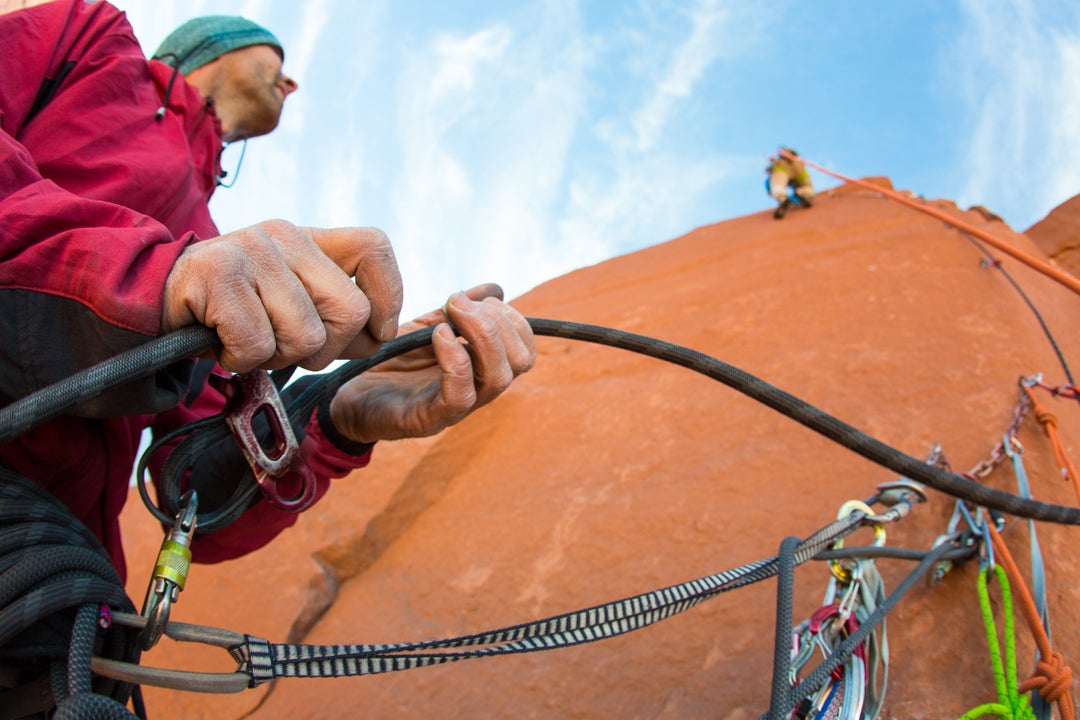
"Showed up in a swami belt, refused to use a belay device, and made fun of my figure-eight knot. One star."
The post Painfully Honest Climbing-Partner Reviews appeared first on Climbing.
]]>

Steve
★★★★★
Steve is a great belayer. After I whipped five times, hung for 10 minutes, pulled off a block and nearly hit him, pitched a wobbler, aided through the move, whipped again, cried for six minutes, swore off climbing for good, threw my right shoe, whipped three more times, hung for 20 more minutes during which I fell asleep, then climbed the remainder of the route clean, he gave me a cookie and said that it happens to everyone. I think he wants to sleep with me. (Not happening.)
—Candace L., Denver, CO

Janice
★★☆☆☆
Waiting.
That’s what you can expect with Janice.
To start, I had a reservation for Janice to pick me up at 7:00 a.m. to leave for Clear Creek Canyon, yet she did not arrive until 7:06. While this may seem like a minor inconvenience, it meant that every good warm-up was taken by the time we reached the Canal Zone. And the waiting did not stop there. When Janice offered to hang a toprope on Turkey Jerky (5.10b/c), I expected that she would redpoint the route and be back on the ground within 5 minutes—her Mountain Project profile says she leads 5.12a. Instead, Janice required three hangs and 12 minutes, wasting valuable time that I could have spent climbing the many nearby 5.8s. Then, before she would belay me, Janice made me wait six more minutes while she drank water and ate an apple. In total, we were at the cliff for 24 minutes before I received my first belay.
While Janice was pleasant enough, I’ll seek a more efficient ropegun in the future.
—Sarah M., Golden, CO

Amanda
★★★☆☆
Ambience: 5/5—Amanda chose a road-side crag stacked with moderates. Kudos. I hate hiking—it’s hard because it’s so boring. Plus, college students in hammocks suggested a fun party atmosphere.
Soundtrack: 4/5—Brought Bluetooth speakers and played “Californication” by Red Hot Chili Peppers on repeat. While this was hella tight, I would have enjoyed more RHCP variety such as “Under the Bridge” every third rotation. Bonus: Treble-heavy small speaker drowned out annoying nature sounds like faint breeze through trees and birds.
Belaying: 3/5—Gave an attentive enough belay, but provided no encouragement such as “You got this, Carl,” “¡Venga!” or “Don’t forget to breathe.” Furthermore, when I got scared and yelled, “Watch me,” Amanda yelled back, “Do you think I don’t pay attention when you don’t tell me to?” It was a valid point, but I did not appreciate her sarcasm.
Other notes: Cons—Does not own car and must be picked up. Dreadlocks got tangled in belay device on multiple occasions. May have been high. Pros—Has Indian Creek rack. Helped untangle my beard from the belay device. Offered me weed.
—Carl D., Boulder, CO

Norman
★☆☆☆☆
Showed up in a swami belt, refused to use a belay device, and made fun of my figure-eight knot. Said climbers today are cowards then showed me scar from the time Layton Kor dropped him 60 feet and he needed an emergency nephrectomy. Never climbed; just smoked.
—Kelly S., Longmont, CO

Ryan
★★★★☆
If I had to rate the snacks in Ryan’s backpack, it would be 7 stars out of 5—but I need to subtract 3 stars for his rude demeanor. To start, I ate half an onion bagel with chicken salad, cheddar cheese, and green apple slices that I found in the brain of his pack while he tied in. Unfortunately, the delicate interplay between the sharp cheese and tart apple was overshadowed when Ryan yelled, “Hey, did you go through my pack?” Of course I did: I was eating his sandwich. Is he not familiar with the brotherhood of the rope? Climbing partners share with one another.
Next, while Ryan led out and slack ran through my ATC (don’t worry—I tied a catastrophe knot), I explored the back pocket of his pack and found an Almond Joy. Great! I was delighted by the exotic combination of coconut and nut. Yet after he clipped in direct to the third bolt, he looked down and screamed, “Dude, seriously! What the fuck? Stay out of my pack!” I found his language offensive.
The last straw came after I found a Tupperware of chicken tikka masala at the bottom of his bag. What a delight! I could tell from the fresh aroma that it had been purchased within the past three days. Then Ryan whipped, causing the catastrophe knot to jam in my ATC after he took a 35-foot fall that pulled me into the wall and spilled the masala. Instead of apologizing, Ryan directed a string of expletives at me that I will not repeat here. There was no salvaging the situation. Sure, I could have rinsed off the chicken with my water bottle, but that would have washed off the sauce.
A few other minor complaints: No vegan or gluten-free options. Only one summit beer available: Pabst Blue Ribbon; would have preferred a local craft IPA or a saison. Despite negatives, I would happily climb with Ryan again, but he has instructed me that there is “no fucking way,” and that if he did, it would only be so he could “tie the rope off to a tree and leave you to hang there and think about what an awful person you are.” Rude!
—Mike C., Golden, CO

Mike
☆☆☆☆☆
Let go of belay device while I was on lead to eat all the food in my pack. Insisted it was some kind of bonding ritual. Later saw him sleeping under an overpass. I don’t think he even climbs.
—Ryan F., Thornton, CO
Illustrations by Claire Eckstrom
The post Painfully Honest Climbing-Partner Reviews appeared first on Climbing.
]]>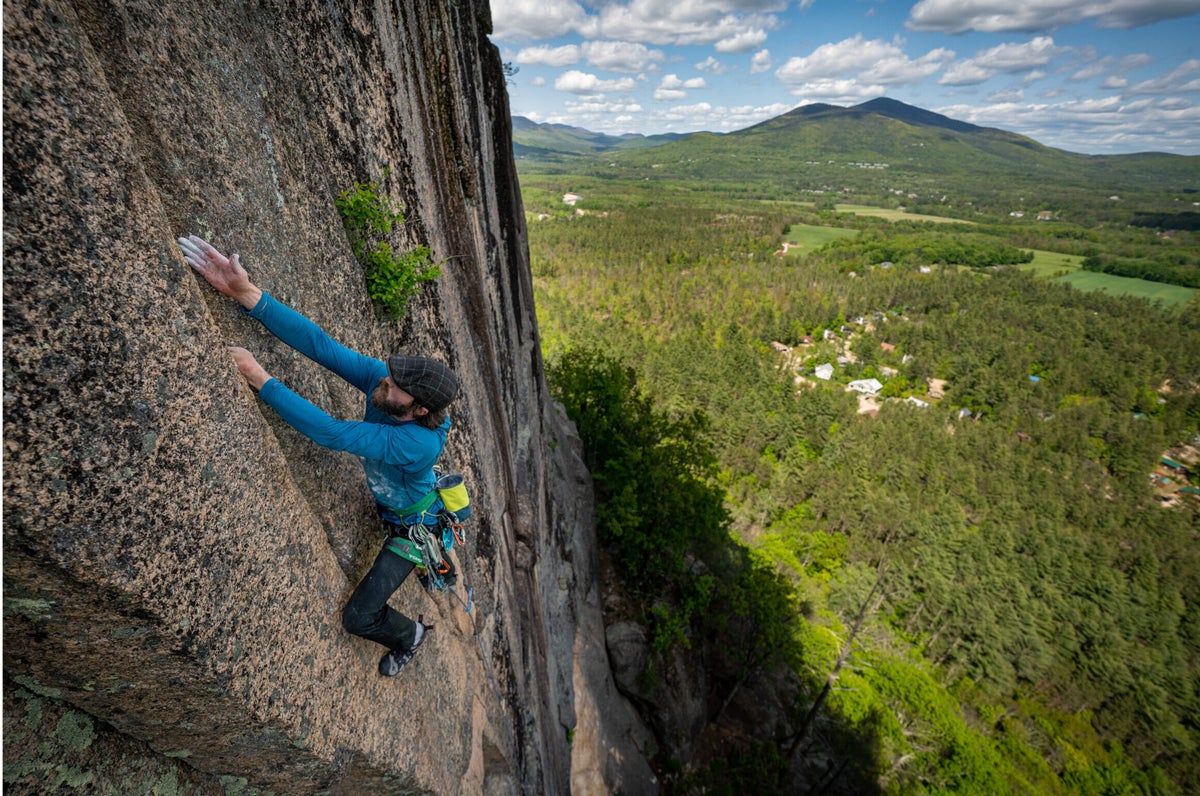
The most difficult challenge we climbers have ever faced is not the Dawn Wall. It’s explaining rock climbing to non-climbers.
The post FAQs: The Nagging Questions Non-Climbers Ask About Climbing appeared first on Climbing.
]]>
The most difficult challenge we climbers have ever faced is not the Dawn Wall. It’s explaining rock climbing to our mothers (with the exception of Brooke Raboutou, Connor Herson, and others born to moms who send).
You see, the general public’s perception of our sport tends to be wildly inaccurate. In an effort to bring greater understanding, we have provided the FAQs below. We encourage you to print these out and send them to any parent, relative, significant other, coworker, acquaintance, doctor, teacher, or NY Times commenter who needs clarification.
Question: Is climbing dangerous?
Answer: When performed properly, rock climbing is relatively safe—it’s likely safer than the drive to the crag. It’s true that accidents do happen. They’re almost always due to user error. If you believe your beloved climber and their partners are smart and responsible, you don’t have much to worry about. If the climber in your life is a reckless idiot, however, feel free to become worried—very worried.
Yosemite National Park estimates that visitors climb a cumulative 25,000 to 50,000 days in the park every year, and the average number of annual climbing deaths is 2.5. That’s .01% if we estimate high.
Question: But what happens if you fall?
Answer: The rope catches us. Why do you think we tie into the rope? Climbing falls are very common and usually a non-event. We typically free fall 10 feet or so, then the rope begins to stretch, slowing us down gradually. It’s more common to injure an ankle swinging into the wall during a fall, or hurt a finger due to overuse, than anything serious.
Don’t believe us? Check out our Weekend Whipper Archive.
Question: What about that guy who climbs without a rope? You don’t do that, do you?
Answer: We get this one a lot. It’s perhaps the most frequently asked questions by non-climbers since 2018. An extremely small percentage of climbers, including Alex “that one guy” Honnold, sometimes climb without a rope. Millions of people go rock climbing in the United States every year, and most of us view climbing without a rope as an unacceptable risk. That’s because, like most human beings, we fear death. That said, free soloing is very dangerous. People who do it sometimes do die.
Question: How do you get the rope up there?
Answer: We climb up with the rope hanging from our harness and clip it to thingies in the rock as we go up. Sometimes we clip the rope to metal bolts drilled into the wall. Sometimes there are no bolts, and we place aluminum devices and chocks called protection into cracks as we go (this is called trad, short for “traditional” climbing). Both are more than capable of holding the weight of a car. They’re very secure, designed by smart people with engineering degrees, and thoroughly tested. Then the leader who “gets the rope up there” can secure it to an anchor for others to toprope the climb. If you’re toproping the climb and you fall, your fall will be minuscule (assuming, of course, that you have a good belayer).
If we fall while climbing above our last clip, we’ll fall twice the distance between us and the clip, plus a little more due to rope stretch. The rope stretch absorbs most of the force, so the load on the bolt or protection isn’t substantial. Actually, the higher we are off the ground, the more the rope can stretch, and the safer it is to fall. Weird, right?! We do have to worry about landing on ledges below, which is why climbing across roofs, while appearing the most dangerous, is actually the safest, Mom.
For more information, check out A Beginner’s Guide to Lead Climbing
Question: Are climbers adrenaline junkie daredevils?
Answer: No. Adrenaline junkies usually prefer to huck their bodies off things (see BASE jumping, wingsuit flying, freestyle motocross, etc.). While there is some crossover with climbers who enjoy climbing up something, then jumping off, the goal of climbing is usually not to plummet through the air. Climbers prefer to be calm and controlled. Our sport is closer to gymnastics than jumping a skateboard over a flaming bus. It’s kind of like solving a puzzle using every muscle in your body.
Question: You must be so strong! I bet you can do like 100 pull-ups.
Answer: It doesn’t hurt to be able to crank out pull-ups for days, but—believe it or not—it’s not that important. Rock climbing is more about finger strength, core strength, and most importantly, technique. We try to keep our weight on our feet and use leg muscles to push us up the wall whenever possible. If you see someone pulling himself up a wall then he is, yes, absurdly strong, but also possibly a terrible climber.
Question: If a climber is injured and requires rescue, will my taxes go up? I am not concerned with human life, only my gross personal income.
Answer: It’s true that search and rescue teams receive tax money, but not much. For example, Rocky Mountain Rescue is all volunteers and operates on just $40,000 a year (and some of that is from donations and grants). Yosemite’s team only spends 10% of their time on climbers; they mostly help lost or injured hikers. So why don’t you try asking your out-of-shape hiker friend this same question? Also, spending every moment worrying about taxes is a sad way to go through life. Consider finding a hobby. May we suggest rock climbing?
Question: Don’t you get scared up there?
Answer: Yes. As with any scary activity, we do on purpose, like riding a rollercoaster, watching horror films, or singing karaoke in front of strangers, that’s part of the fun.
Question: Why do you do it?
Answer: It could be the satisfaction of overcoming seemingly impossible physical challenges. Or maybe it’s the gratification that comes from experiencing beautiful natural areas from vantages few others will ever see. There’s also the simple joy of spending a day outside with friends. I don’t know. It’s better than sitting on the couch watching Netflix.
The post FAQs: The Nagging Questions Non-Climbers Ask About Climbing appeared first on Climbing.
]]>
This is one of the worst anchors we've ever seen and is an inappropriate use of equipment.
The post A Terrible, Horrible, No-Good, Very Bad Anchor appeared first on Climbing.
]]>
We were toproping in the Gunks when an older climber showed up to lead Ken’s Crack (5.7+) next to us. We learned he’d been climbing for 50+ years, but the leading and belaying techniques in his group were pretty poor. Despite this, he casually cruised up the route. He then asked if he could share one of the trees in our anchor for his own toprope. We told him it was fine. I later saw his anchor (picture, the red and white sling is part of our anchor). Cross-loaded carabiners, lack of redundancy, non-lockers, leg loops of a harness as webbing, etc. I was pretty uncomfortable with the situation. Unfortunately there was a strong language barrier, and he’d been climbing for twice as long as I’d been alive, so I didn’t feel like my feedback would have any effect.—Alex, via email
LESSON: This is one of the worst anchors I’ve ever seen, but it did get me wondering: Is it really unsafe to use leg loops like this? Are leg loops just perfectly good nylon slings with some extra padding? I reached out to Misty Mountain, and Sales Manager Philip Hoffman had this to say:
“This is a God awful, terrible setup and in no way shape or form is our equipment to be used in this fashion. The ‘leg loops’ do not even appear to be leg loops, but actually look like gear slings. I have no way of knowing if they are gear slings or not without visually and physically inspect them in person. I just cannot tell what piece of equipment they are in this photo. What I can tell you is, whether they are leg loops or gear slings, this is NOT the application for which they are to be used. Once again, this method of use for this equipment is not something that Misty Mountain recommends or condones.”
That’s about what I was expecting. Strikes one, two, and three are for using inappropriate equipment for the primary anchor material. If that fails, the whole anchor fails. I’m not going to pick out every single other problem with the anchor (everything), but I encourage our readers to do so in the comments. What this anchor doesn’t safely accomplish with 10 pieces of gear, you can easily accomplish with just three: a static line and two locking carabiners. Secure the static line around each tree. Extend a bight of rope from between both trees down over the cliff edge. Tie a BHK (Big Honkin’ Knot, or BFK for those with potty mouths) in the bight hanging over the edge. Clip the two lockers (opposite and opposed) to the two loops coming out of the BHK. Your climbing rope goes through both of these lockers. Done. Easy.* Static rope is a great material for natural toprope anchors because it’s strong, abrasion resistant, and allows you to extend your masterpoint as far as you need.
*Please don’t try to build your own anchor with only these few sentences of instruction. Do more research and/or seek a qualified instructor first. It’s not easy to explain how to properly set up a BHK anchor with just words.
Also Read:
- The 20 Most Amazing Alex Honnold Facts
- Field Tested: Ocun’s Sigma Is a Sport Climbing Machine
- Weekend Whipper: Why Linking Pitches Can Lead to Huge Falls
The post A Terrible, Horrible, No-Good, Very Bad Anchor appeared first on Climbing.
]]>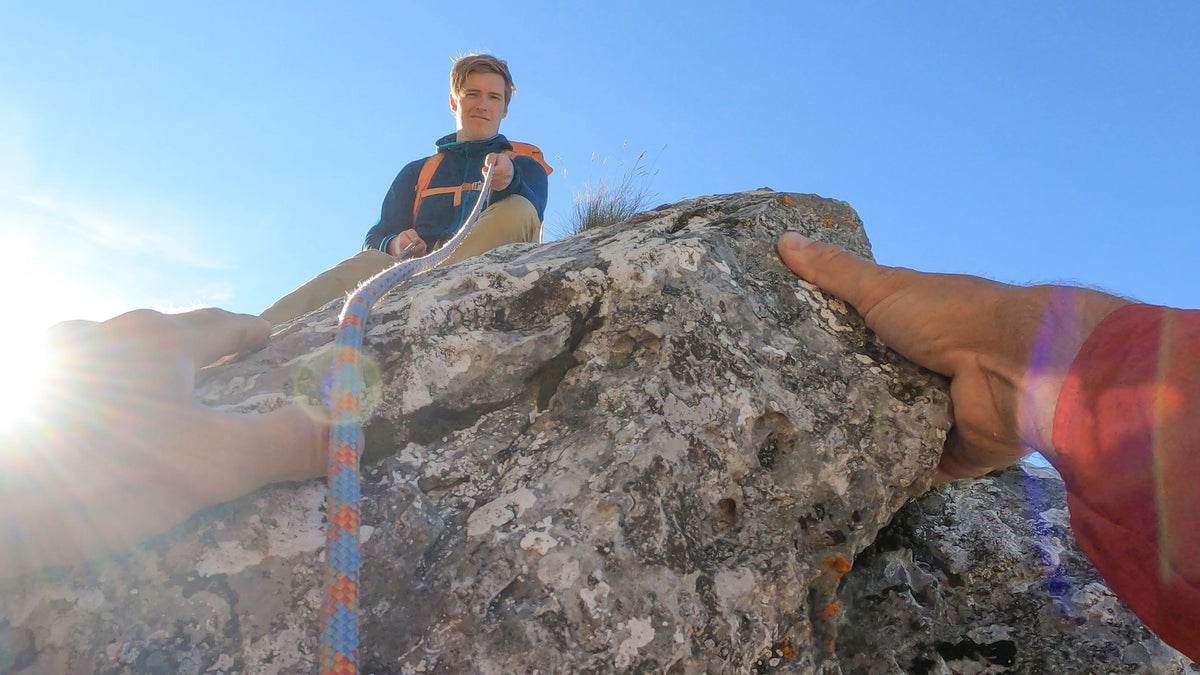
This anchorless belay relied on bodyweight and broke all the rules in the book, including some that weren't even in there.
The post He Used a Human As the Belay Anchor. Really? (Yes, Really) appeared first on Climbing.
]]>
I saw a big guy struggling to rope-solo up a tricky 5.8. He was using an ascender, and he wasn’t taking up slack very well. The real problem was at the top of the cliff. His “anchor” was his smaller buddy, sitting five feet from the edge, holding the rope around his hip. I explained that a fall would’ve yanked them both off the cliff, but got blank stares.
—Submitted by Ed, via Climbing.com
LESSON: Use common sense and think through worst-case scenarios. Nothing about this “meat anchor” is ERNEST (equalized, redundant, no extension, solid, timely), and it put two lives at risk. It actually takes quite a lot to hold someone on a rope, more than you may think. If the “soloist” had fallen he likely would have dragged his buddy off the top of the cliff. Plus, if you have a partner, just have her secure to a proper anchor and belay you. There is no advantage to toprope soloing, and using an ascender for a self-belay device is yet another bad idea. There are numerous devices and techniques that are proven and work better than ascenders. Very likely these two climbers were rank beginners as evidenced, among other things, by using a hip belay. Holding someone on a hip belay takes practice (and heavy clothing, unless you want rope burns) and went out of favor oh, about 50 years ago when belay devices became popular. You would have done well to intervene with a bit of friendly advice. Stepping in like that can be awkward, but not as bad as calling 911 and rendering first aid.
Also Read: Here’s a Dangerous Belayer You Won’t Want To Climb With
A new climber set up a toprope by clipping one quickdraw between two bolts. Not only was the rope unsecured and running against a nylon sling, but the angle between the bolts was about 170°.—Submitted by Cameron Hunt, via Facebook
LESSON: Basic anchor principles aside, two things make this especially dangerous. First, a nylon rope rubbing against a nylon sling under weight will generate a lot of heat. There’s a good chance the sling will melt. Metal should be used between all soft goods. Second, the wide angle would multiply the force generated in a fall. With a 30° angle, each bolt bears 52 percent of the original load. With a 120° angle, each bolt bears 100 percent of the original load—lower loads on the anchor are always better than higher loads. Using longer slings to decrease the angle, decreasing the load is a no brainer.
Climber: “Take!” Belayer: “Hold on. Let me finish texting my mom.”—Submitted by George Terrizzi, via Facebook
LESSON: Put the phone away and pay strict attention to your climber. “Take” is a serious command that warrants an immediate response. You can tell your mom you love her when you get home.
Want more? Check out more installments in our ever-growing hall of dangerous behavior:
Climbed On Webbing Instead of Rope
Used Hands for Belay … No Device
Actually used a Grappling Hook for Climbing
Belay Device Somehow Unclipped Itself, And Leader Fell
They Used Parachute Cord For Slings
No belay Anchor on Multi Pitch, and Leader Falls
Lucky He Didn’t Die. Lowered From a Toy Carabiner
Unfortunate Groundfall, Fortunate Landing
Leader Decks When Experienced Climber Bungles the Belay
Saw Through Someone Else’s Rope
Belayed With Hands Only—No Device!
Smoke Brick Weed and Go Climbing
Belay With a Knife In Your Hand
The post He Used a Human As the Belay Anchor. Really? (Yes, Really) appeared first on Climbing.
]]>
Five ways to customize hangboard training to make it easier or harder.
The post Hangboarding Is For Everyone. Get Started Now. appeared first on Climbing.
]]>
Hangboards are an excellent tool for training finger strength, yet the available edges are rarely the exact-right difficulty. If you’re new to hangboarding, all of the edges might seem impossible. Or maybe you can hang from the largest edge, but the next size down is way too hard. Looking at the board, you might assume that the edge depths are the only variable when it comes to difficulty. You might also get the idea that training on the large edge will make you strong enough to train on smaller edges. Actually, there’s more you can, and should, do to adjust the difficulty of your finger training.
Think of it this way: If you could curl a 50-pound dumbbell and wanted to improve, you wouldn’t jump right up to a 100-pound dumbbell. You’d use a 55 pound dumbbell first, then a 60-pound dumbbell, etc. You’d increase the difficulty in small steps.
The same principle applies to finger strength. This article is intended for the novice hangboarder. It’ll help you dial in the proper difficulty so you can train effectively, no matter how strong you are to start.

The post Hangboarding Is For Everyone. Get Started Now. appeared first on Climbing.
]]>
It's a fantastical, unbelievable story, but the unbelievable really happened.
The post Belay Device Unclipped Itself … And Leader Fell appeared first on Climbing.
]]>

We were climbing at Chuckwalla in southern Utah when we witnessed a belay accident. My partner had just reached the top of his route. As I started to lower him, I heard a rope zipping freely. I looked to my left, and a climber was in a free fall about 60 feet up. Then he stopped suddenly. His belayer looked astonished. His belay device had somehow come off his harness and was now jammed into the first quickdraw. It was the only thing holding the climber. We quickly had someone put the climber back on belay and removed the jammed device from the rope. The worst part is that the belayer had no idea how it happened.
—Eric Freiberg, via email
LESSON: This one does sound a bit fantastic—how did the quickdraw lock the rope?—but crazy stuff happens all the time, so on that note… Unless the belayer’s harness broke, there’s really only one way this can happen. The belay carabiner had to unclip itself from the harness. That’s only possible if it wasn’t locked. Always check that your belay carabiner is locked, and then have your partner double-check before she starts climbing. For added assurance, use an auto-locking carabiner so it can’t unscrew itself during the climb, and choose an anti-cross-loading design that keeps the harness and carabiner in the proper orientation such as the Metolius Gatekeeper.
Want more? Check out more installments in our ever-growing hall of dangerous behavior:
They Used Parachute Cord For Slings
No belay Anchor on Multi Pitch, and Leader Falls
Lucky He Didn’t Die. Lowered From a Toy Carabiner
Unfortunate Groundfall, Fortunate Landing
Leader Decks When Experienced Climber Bungles the Belay
Saw Through Someone Else’s Rope
Belayed With Hands Only—No Device!
Smoke Brick Weed and Go Climbing
Belay With a Knife In Your Hand
Don’t Let a Clueless Dad Take a Kid Climbing
She Got Frustrated and Untied—On Lead
The post Belay Device Unclipped Itself … And Leader Fell appeared first on Climbing.
]]>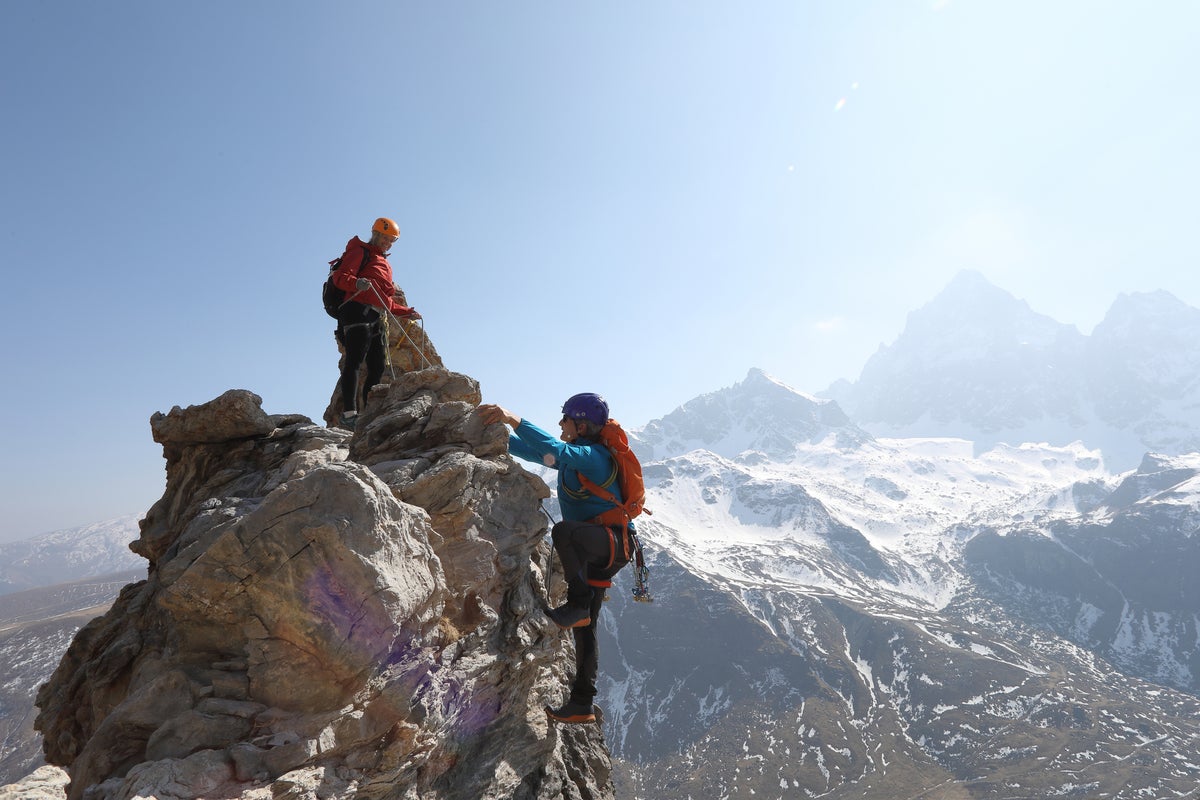
The guide was right about the loose boulder, but wrong to jiggle it.
The post The Guide Who Could Have Killed Them appeared first on Climbing.
]]>
Last summer I was climbing at Little Tryfan. We were on a two-pitch route. At the top, I built an anchor by slinging a boulder and placing two nuts. The boulder was about the size of three tires and appeared solid. Just as I’d shouted down for my second to start climbing, a guide popped up with two clients. He told them, “If you ever climb here, don’t use that boulder. It moves.” I turned and asked, “The one I’m using?” He said yes, and stressed that you should always test boulders. I wasn’t too concerned because I was confident in my nuts and still thought the boulder was big enough that it wouldn’t go anywhere. I went to check on my partner by peaking over the edge, leaning my weight on the anchor. I felt myself jerk forwards a few inches. I turned to see what had happened and saw the guide jumping on the block, trying with all his might to move it. I was in complete shock. Before I could gather my thoughts, he’d already moved on. When my partner topped out I apologized profusely for using the bad block. I tried to find the guide to confront him, but couldn’t. I still can’t believe what he did.
—Benjamin Steele, via email
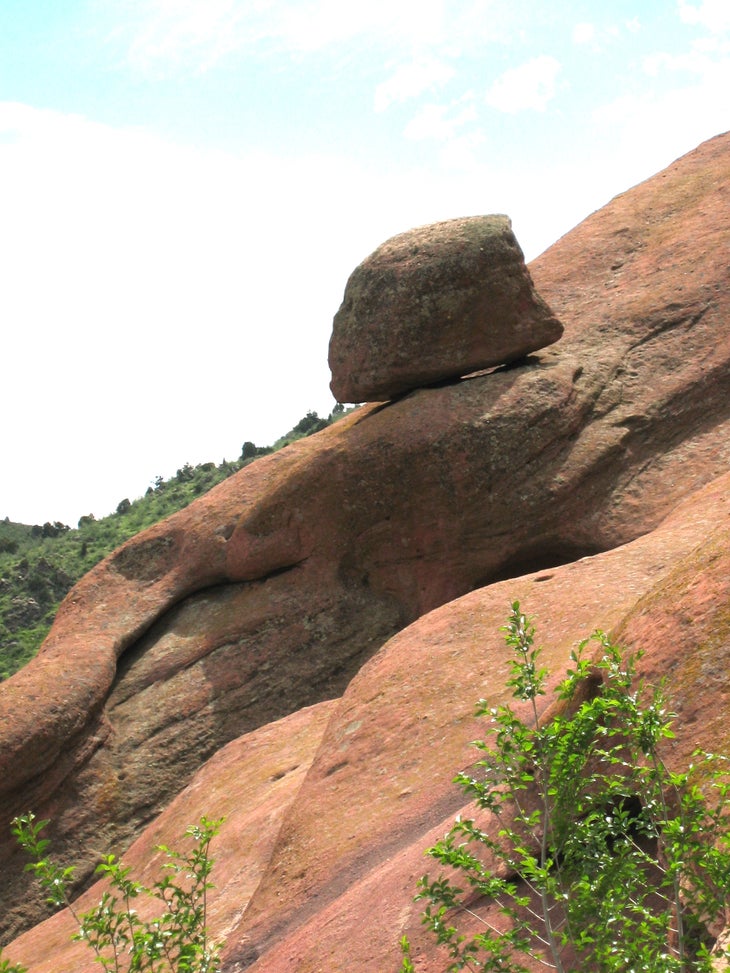
LESSON: We can learn a lot from this guide. First, he’s right about boulders. You should always make sure a boulder is completely solid before using it in an anchor. If you can move it at all, even if it’s just a wobble, avoid it. A tank-sized block can skitter off a cliff with little provocation if it’s perched precariously. No matter how many backup nuts you’ve placed, it’s not good for a big block to fall off a cliff while it’s attached to your anchor.
This guide also teaches us what not to do. Don’t mess with the integrity of another climber’s anchor. Ever. This maniac should’ve waited until Benjamin and his partner were both off belay at the top of the cliff before he even touched that boulder. If you think an anchor is unsafe and want to help, talk to the climber using it. You can offer to place another piece, screw an open locker shut, etc. Don’t mess with it without asking. Anchors are too important for that kind of behavior. Proving that a block is unsafe by jumping on it, while a climber is weighting it? That’s completely insane, bordering on attempted murder.
Want more? Check out these additional installments
What’s Wrong With This Anchor?
Thought Home Depot Rope Was Fine For Climbing
Leader Decks When Experienced Climber Bungles the Belay
Saw Through Someone Else’s Rope
Belayed With Hands Only—No Device!
Smoke Brick Weed and Go Climbing
Belay With a Knife In Your Hand
Don’t Let a Clueless Dad Take a Kid Climbing
She Got Frustrated and Untied—On Lead
The post The Guide Who Could Have Killed Them appeared first on Climbing.
]]>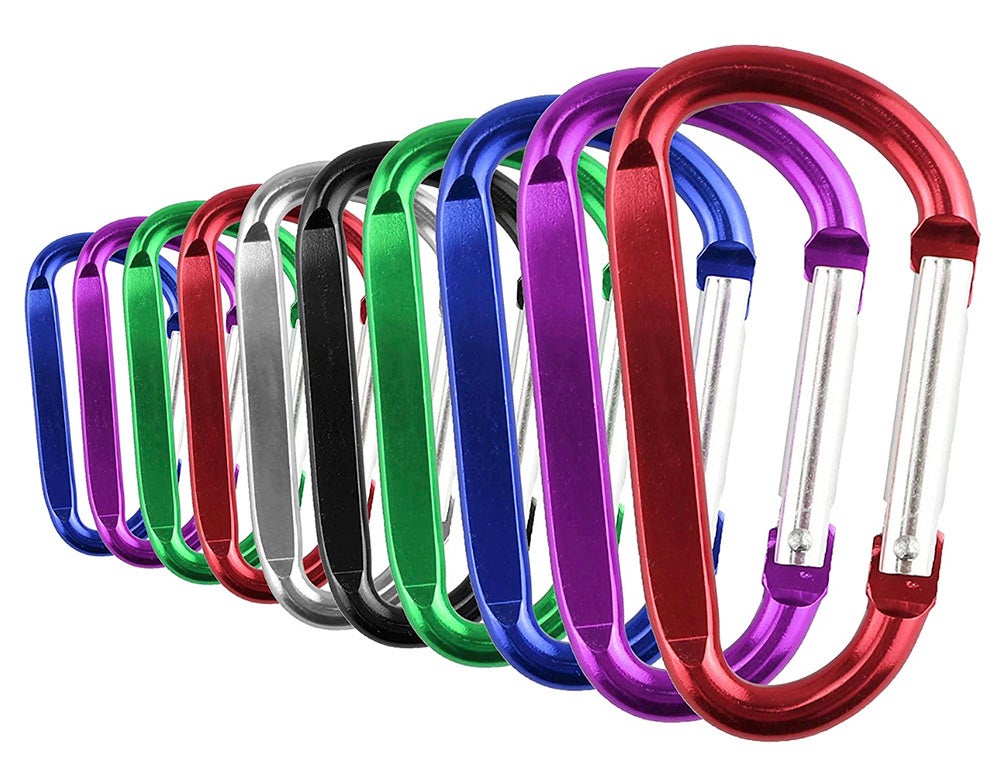
This guy's cheapness brought danger to a new level.
The post Lucky He Didn’t Die: Lowered From A Toy Carabiner appeared first on Climbing.
]]>
I watched a guy try his first sport lead outside. He bailed after the fourth bolt. None of his friends wanted to try the route, so an older climber instructed him to thread the rope directly through the bolt hanger so he wouldn’t have to leave a bail carabiner. Then the older gentleman proudly recounted a story of how he was two pitches up on a route and couldn’t finish it. Instead of leaving a real carabiner behind, he used a toy carabiner because it was cheaper. He said, “Those things only hold 500 lbs. or so, but I was just too cheap to leave a real carabiner.”—Kevin Kuo, via email
LESSON: There are many ways to safely bail off a sport route. Threading the rope directly through a bolt hanger is usually not one of them. Take a gander at the methods in the linked article and be sure to carry a couple bail carabiners or quick links in case you need to go down because you can no longer go up. Though slightly more expensive (really only a couple bucks), it’s more polite to leave carabiners. At best, quick links are hard to remove for the next person that leads the route. At worst, they can rust shut and become very hard to remove. Keep in mind that you may be able to retrieve gear by walking to the top of the cliff and rappelling, climbing the next route over, or asking a stronger friend to climb the route.
Toy carabiners usually have something like “Not for climbing” or “Not load bearing” printed right on them, because they’re not load bearing. 500 lbs is a very generous estimate. They’re intended to hold a set of keys or maybe a waterbottle. Absolutely not a person. If your life is worth so little to you that you’re willing to risk it instead of leaving behind gear that costs roughly the price of a hamburger, then I can’t help you. You’ll get better advice from a therapist.
Want more? Check out more installments in our ever-growing hall of shame:
Leader Decks When Experienced Climber Bungles the Belay
Saw Through Someone Else’s Rope
Belayed With Hands Only—No Device!
Smoke Brick Weed and Go Climbing
Belay With a Knife In Your Hand
Don’t Let a Clueless Dad Take a Kid Climbing
She Got Frustrated and Untied—On Lead
The post Lucky He Didn’t Die: Lowered From A Toy Carabiner appeared first on Climbing.
]]>
They figured they knew enough about climbing to wing it, but took a dangerous risk that could have cost them.
The post They Climbed On a Home Depot Rope—Thought A Real Rope Was Too Expensive appeared first on Climbing.
]]>
During my senior year of high school, my friends and I were bored. We decided we collectively knew enough about climbing for it to be safe. We went to the local outfitter and bought harnesses, carabiners, and belay devices, but we scoffed at the price of a rope. It was way outside our budget. Instead, we went to Home Depot and bought 100 feet of poly cord that was rated for 200 pounds. We climbed on that rope all day, just easy 5.3 climbing on toprope. I’ve included a couple photos. It wasn’t until I was lowering at the end of the day that I realized what a mistake I’d made. The 100-foot rope had stretched to about 200 feet, shrinking to the size of 8mm cord. I bought a real climbing rope the following week. Wanted to share because we are all new at some point and even with the best intentions mistakes are made. We should collectively work together to improve safety across the sport. I wish someone would have stopped us from climbing on that poly rope.
—Kyle Harris, via email
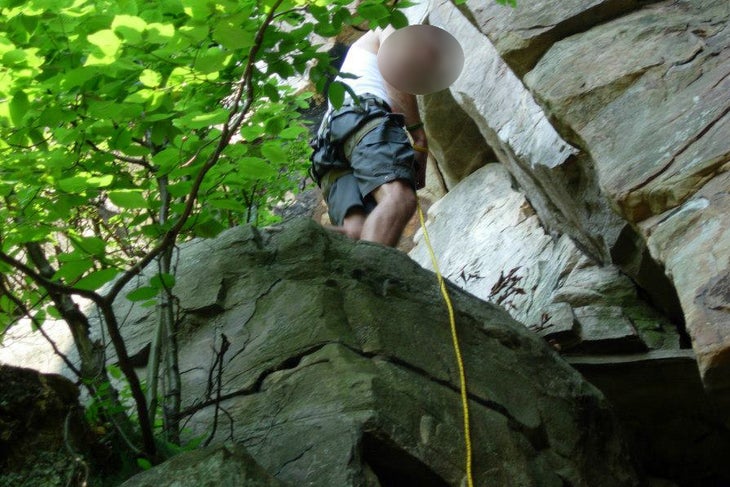 —
—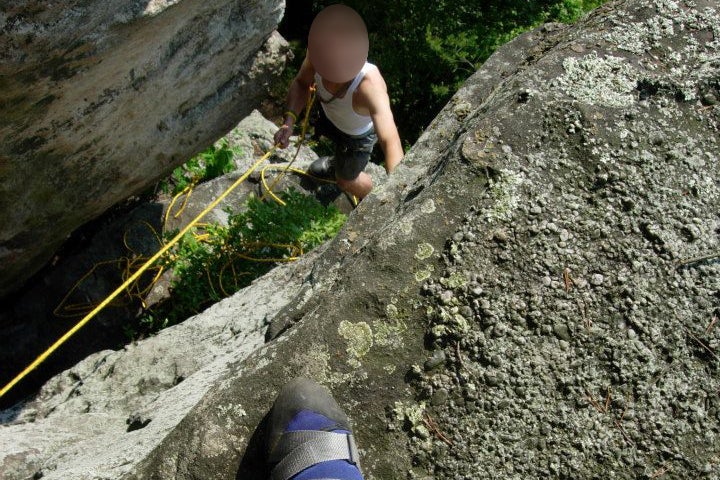
LESSON: Modern climbing ropes include a number of climber-friendly features. They can hold thousands of pounds of force. They have durable sheaths that prevent abrasion and cutting. They have the ideal amount of stretch to catch a fall softly, and then bounce back to their original length and diameter. They’re supple and easy to tie and untie. They’re tested to meet rigorous safety standards. And they work great with modern belay devices. A random hardware store rope is not designed with any of these goals in mind, and can’t be expected to meet them. Always use proper climbing gear designed and rated for climbing.
Want more? Check out more installments in our ever-growing hall of shame:
Lucky He Didn’t Die. Lowered From a Toy Carabiner
Unfortunate Groundfall, Fortunate Landing
Leader Decks When Experienced Climber Bungles the Belay
Saw Through Someone Else’s Rope
Belayed With Hands Only—No Device!
Smoke Brick Weed and Go Climbing
Belay With a Knife In Your Hand
Don’t Let a Clueless Dad Take a Kid Climbing
The post They Climbed On a Home Depot Rope—Thought A Real Rope Was Too Expensive appeared first on Climbing.
]]>
Ascend blank corners with this handbook on stemming.
The post Two Blank Walls Make a Jug. Learn To Stem! appeared first on Climbing.
]]>
With a right foot pushing into one wall and a left foot pushing into another, stemming is one of the most natural ways to climb. You can more or less stand straight up on your legs instead of hanging on your arms. It’s most common in dihedrals and chimneys, anywhere you find a corner that’s narrow enough to bridge the gap with your lower body. Stemming can get you past completely blank sections of rock and provide a much-needed rest in a spot where there are no jugs. You might be fingerlocking in a crack in the corner, palming the walls to push your way up, or crimping tiny face holds on the outside, but the key to good stemming technique is all in the feet. It might feel less secure than standard face and crack climbing because you’re relying heavily on friction, but follow this guidance to float even the cleanest corners.
How to stem
Push
No amount of mono pull-ups or finger strength will help you up a holdless corner. Stemming is all about oppositional force. Both arms and legs should be pressing outward on opposing faces to support your weight. If using face holds or a crack with your hands, maintain three points of contact, using your hands only to hold your body in place while you move your feet up. If you’re palming the wall with your hands, point fingers down or backward, away from the corner. Push hard and shift your weight between your arms to move each foot up. Focus your force into three limbs until you can unweight a hand or foot, raise it up, then repeat. Upward progress will come from your feet, since you are essentially standing on the wall. Concentrate on moving feet first, and only use your arms for balance.
Experiment
Depending on the shape of the corner, the traditional stemming position (pictured above, facing the corner, with both arms and legs out like an X) may not be the optimal approach. Experiment to find the best body position. Hands can jam a crack, layback a seam, grab a face hold—whatever you can do to stay solid and walk your way up the wall. Sometimes back-stepping on one side to push your hip into the wall will be ideal. In a narrower corner, you may be better off chimneying: pressing your back into one wall with your feet against the other. Between wide walls you might have to employ a bridge technique by placing both hands on one wall and both feet on the other, putting your body almost horizontal across the gap. These sections frequently lack good protection and require a strong head; success depends on maintaining confidence.
Train
Stemming relies on pushing muscles rarely engaged by climbers, specifically the triceps, glutes, calves, and small outer hip muscles. The core is also really important for performing the balance-intensive weight-shifting and high-stepping moves; you need to be able to stay tight from your hand all the way down through your opposing foot. Consider adding some weightlifting exercises that focus on these muscles: dips, pushups, planks, side planks, calf raises, overhead shoulder press. When doing these exercises, concentrate on achieving the slow burn that closely resembles the endurance required for doing these moves for a longer period. Choose a moderate weight and go for high reps or time.
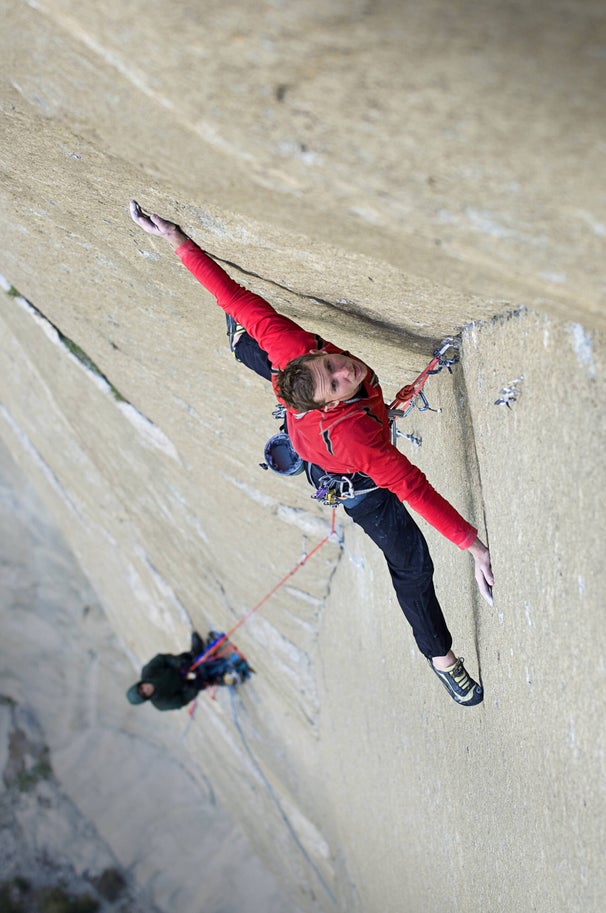
Rest
While singular stemming moves might not feel taxing, maintaining oppositional force for a whole pitch will sap your strength fast. Take every opportunity to shake out an arm or a leg. Unlike with face climbing, your forearms won’t limit you in a corner; the pump clock will be counting down on your calves as you smear. Keep your heels as low as possible to maximize friction and minimize calf fatigue. Many positions can be turned into a rest, allowing you to shake out one limb. Any time you find a foot chip or ledge, stand straight down on it to relax your other leg. Even just a second of this will get some much-needed blood flow into your large leg muscles. In some circumstances you may be able to lean a shoulder into the wall, or even your back, for a more secure and less exerting breather. If you find any down-pulling jugs, consider hanging completely on your arms to shake your legs out.
Stylistic Stemming With Jesse Huey
Jesse Huey has been stemming blank corners for 16 years, including freeing El Cap in a day and numerous first ascents all over the world.
Start Stretching
Stemming isn’t about strong biceps, forearms, and fingers of steel; it’s about balance and hip flexibility. I’d argue that stretching or yoga are just as valuable as hangboarding. I was always fairly flexible, but practicing yoga led to huge leaps in my stemming ability.
Feet
A hard stemming corner won’t have footholds, so think about where you need one to stay in balance. It’s all about pressure and friction, so ask yourself, “Where do I need to place my foot to stay in balance?” Usually it’s much higher and wider than you want.
Hands
Rock always has divots or imperfections. The Teflon Corner on El Cap has a stemming sequence that looks blank. But when you feel the wall, your palms fit into undulations and little imperfections. I spot any divots from below and put chalk on them—and I chalk my palms A LOT!
Relax
Resting relies on relaxation and creativity. Fighting my way up a corner seems impossible compared to when I relax and let my body do what it wants to do. Often it takes one attempt to loosen up and find that balance where you are never pushing too hard but trusting the friction. When I’m redlining in my legs, opposing palm holds allow for a millisecond to shake them out.
Get Creative
As a corner gets wider, you need more than a blank wall: a tiny crack or crimp—something! When I freed Moonlight Buttress, I stemmed the crux pitch where most people layback. It drastically took the weight off my fingers and put it on my legs. A narrower corner has more options, like chimneying (with your back against one side). Many stemming corners can be overcome with creative chimneying.
https://www.climbing.com/skills/
https://www.climbing.com/skills/you-suck-how-to-deal-with-regression/
The post Two Blank Walls Make a Jug. Learn To Stem! appeared first on Climbing.
]]>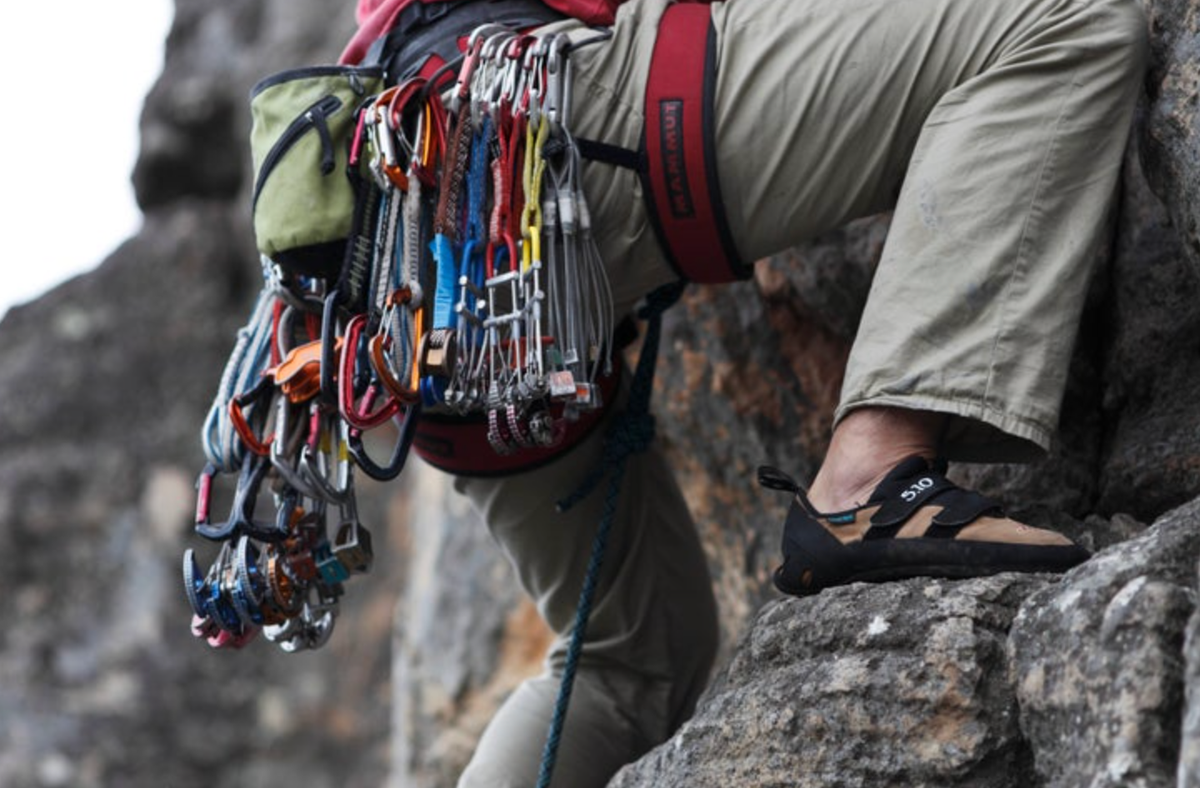
If a nearby climber hadn't intervened the outcome could have been a disaster.
The post Leader Anchored To Gear Loop. Unwelcome Advice Averted Tragedy. appeared first on Climbing.
]]>
As I climbed a route on a crowded wall in the Red River Gorge and reached the anchors, I heard anxious yelling directed at the climber next to me. My buddy Marc on the ground had noticed that the young lady who had just led the route had clipped in direct via a gear loop on the side of her harness and had begun untying her knot to clean the anchor! Marc stopped her and explained why it was dangerous to her belayer. The attitude my buddy received in return was disappointing. Both the belayer and climber acted like he was over-reacting and invading their territory, even though he had not given the information in an adversarial or know-it-all tone. Oh well, at least he prevented an accident that day and hopefully the point got across.—Paul, Red River Gorge, KY
LESSON: We’ve covered gear loops in this column a couple of times, and we’ll probably cover them again because it seems like a common mistake (or maybe misconception). Most gear loops are not strength rated. They’re simply not designed to be load bearing beyond a beefy trad rack. I can’t even tell you what the average gear loop breaks at because manufacturers don’t publish the numbers, and they tend to vary from company to company and harness to harness. The bottom line is that they’re not designed to hold your body weight, so you shouldn’t depend on them to hold your body weight. Even while tied in with the rope, there’s plenty of room to clip a locking carabiner to your belay loop, or girth hitch a personal anchor or sling to your tie in points to go on direct safely.
There are a select few harnesses (such as those in the Metolius Safe Tech line) built with full strength gear loops. While you can clip into those if you want to, hanging from your side still isn’t very practical. Since the girl in the story ultimately heeded Marc’s advice, I’m going to assume she was not wearing a harness with full-strength gear loops.
As for the attitude, maybe they were just hyper sensitive after learning the young lady had put herself in serious danger. Or maybe they’re just jerks. Try not to let it bother you.
Also Read
- Weekend Whipper: A Toe Hook So Good It Won’t Let Go
- The 15 Greatest Ascents of 2023
- Our 10 Most Read Stories
The post Leader Anchored To Gear Loop. Unwelcome Advice Averted Tragedy. appeared first on Climbing.
]]>
Climbing is built on the honor system, which is super easy to take advantage of. Seriously. Here’s how to do it.
The post Why Improve as a Climber When You Can Just Lie? Here’s How To Do It appeared first on Climbing.
]]>
Tommy Caldwell and Kevin Jorgeson spent 7 years working the Dawn Wall before it saw a first free ascent. Nalle Hukkataival worked the world’s first V17 for 3 years. What do these ascents, two of the most incredible climbing breakthroughs in recent history, have in common? We believe both are impressive because the climbers told us so. We’re just taking their word for it! Climbing is built on the honor system, which is super easy to take advantage of. Here’s how to do it.
1. Choose an inconvenient route
First, discourage anyone else from trying your “mega proj.” If some gumbo waddles over with his new lead card and sends your testpiece first go, the jig is up. Keep the crowds away by thinking remote. The Dawn Wall is 32 pitches of supposedly hard free climbing on El Capitan. That alone will discourage most people from checking it out. Sure, maybe the first pitch is legit 5.12, but who’s going to rap all the way down to pitch 15 to confirm that it’s not juggy 5.2? Tommy and Kevin even convinced us all that it must be climbed in really cold temps because of science or something. Anyone want to rap halfway down El Cap in the middle of winter to check out something supposedly too hard to clasp the start holds on? Me neither. Similarly, Nalle’s Burden of Dreams (V17) is in Finland, which is enough to keep most climbers away.
2. Hang out for a while
Adam Ondra sent Jade (V14) on his first try?
“Sounds like a pleasant afternoon.”
The Dawn Wall FA took seven years?
“Wow! What an inspiring story of dedication and the triumph of the human spirit!”
Hard things take a really long time to achieve. If you want people to think you did something bordering on impossible, tell them it took years. Honest question: How do we know Tommy Caldwell wasn’t spending so much time on the Dawn Wall because he was running from creditors? Perhaps he was making himself scarce, lied about why he was on El Cap, and the story snowballed. Suddenly he wasn’t “on the lam”; he was “pushing the boundaries of human potential.” There are plenty of other reasons Tommy could have been hiding up on the Dawn Wall, but none of them explain his missing index finger. The point is, massive fraudulent climbing achievements are a long-term investment. Once you choose your “dream” climb, start killing time. Settle into your portaledge and chip away at that Netflix queue. If it’s a boulder problem, go take a nap in the forest. You need to show people that you’re out there. If you search the Finnish forest around Burden of Dreams, you might just find a Nalle Hukkataival–shaped divot in the dirt, worn away from years of snoozing.
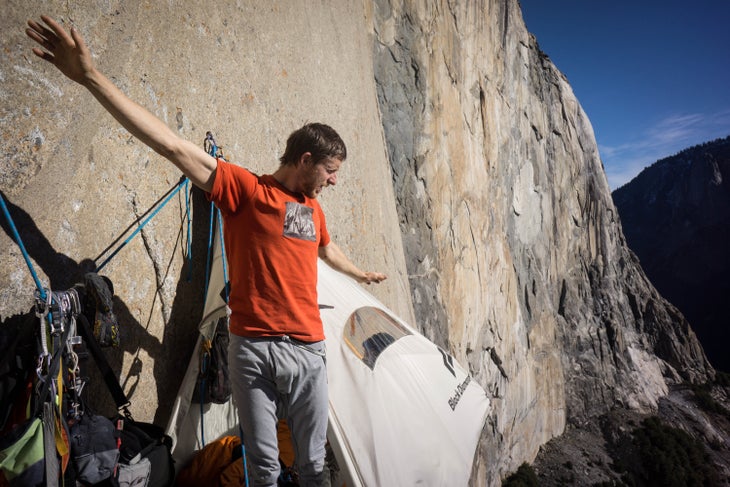
3. Make media
If there are no videos or photos, then it didn’t happen. To prove you did your climb, you need media. TC and K-Jorg had a team of talented media-makers to document their Dawn Wall ascent. Very talented. These people would definitely know how to tilt the camera to make a pitch look 25 degrees steeper, or Photoshop flat ground to look like a pitch on the Dawn Wall. I’m not saying that’s what they did; I’m just saying that they’re skilled enough to do it. That’s all.
Luckily, hard climbing is mostly sitting around while you “recover” and “wait for good temps.” Fill your Instagram feed with lifestyle shots near your climb, and you’re set. Every once in a while, throw in a close-up of blank rock and say it’s the crux hold.
Eventually, you will have to deliver a film. The climbing only has to look hard. Scream a lot. Show failed attempts. A shot where you look angry at your hands is a must. Sure, Burden of Dreams looked impossible on film, but so do some V3s. Look like you’re trying hard, and people will believe you are. It’s called acting.
4. Find accomplices
To solidify your ascent, you need backup: a “repeat” ascensionist. This is a win-win situation for you and your accomplice. You get verification, and she gets an incredible tick for their résumé. Adam Ondra fired off the Dawn Wall in just a few weeks—long enough to make it look like he had to try, but quick enough not to raise suspicion or miss Thanksgiving. Ondra “verified” TC and K-Jorg’s hard ascent and went home a hero. Do you think he’s going to blow anyone’s cover? Not a chance.
For Nalle’s V17, Daniel Woods and Jimmy Webb agreed on camera that it was real, real hard. That was enough “proof” for boulderers.
And if anyone does call you out, just keep lying. If you hold out long enough, then Kelly Cordes will write a book about you—that’s a pretty cool achievement in its own right.
Also Read
- Adam Ondra’s New Film Reveals Some of the Darker Sides of Greatness
- A Ghostly Encounter in Penitente Canyon
- Babsi Zangerl Nabs the 4th Ascent of Meltdown
The post Why Improve as a Climber When You Can Just Lie? Here’s How To Do It appeared first on Climbing.
]]>